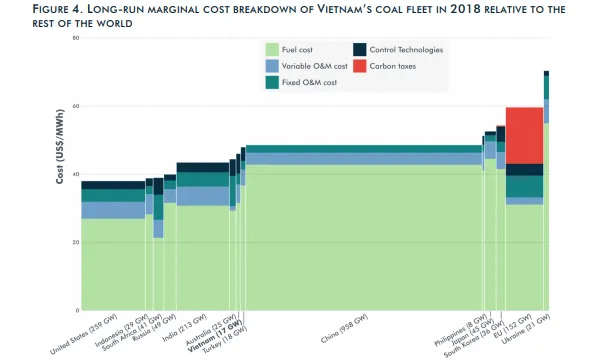
Vietnam risks losing $6.5b of value for coal assets
The risk is escalated by regulatory structures that guarantee high returns for coal generators.
Vietnam is urged to create a retirement schedule for its coal-fired power plants in order to avoid risking $6.5b of stranded assets, which is equivalent to 2.7% of its GDP in 2018, said financial research firm Carbon Tracker.
Stranded asset risk is the difference between the cash flow utilities may receive under the current Vietnamese power market and what they would receive in a below 2°C scenario, which sees capacity closed prematurely to meet the temperature goal in the Paris Agreement.
“Vietnam has a high stranded asset risk relative to the size of its economy. This is due to regulatory structures which effectively guarantee coal generators’ high returns,” said Carbon Tracker. Moreover, beyond the operating coal units and the new coal units under construction, Vietnam also intends to build a further 32GW of coal capacity.
Carbon Tracker argued that coal in Vietnam could be economically obsolete over time when renewables outcompete new, under-construction, and existing coal and when new firm or dispatchable renewables outcompete existing coal.
By 2020, it is expected that it is cheaper to invest in new solar PV than new coal and by 2021 for new onshore wind. “These changing cost dynamics post a significant stranded asset risk if investors and policymakers decide to go ahead with the 32GW of coal capacity in the project pipeline,” Carbon Tracker said.
![]()
Also read: Winds of change: Vietnam pushes for more developments amidst growing energy demand
“The capital recovery period for new investments in coal capacity is typically 15-20 years and therefore we consider these investments high risk, as burning coal to generate power will unlikely be a least-cost option before debt is fully amortised. Moreover, these estimates could prove highly conservative, especially if policymakers introduce reverse auctions,” it added.
Moreover, it could be cheaper to build new solar PV and onshore wind than operate existing coal plants as soon as 2022. Both solar PV and onshore wind deployments in Vietnam have experienced cost reductions over the past four years, declining around 50% and 30%, respectively.
![]()
“We expect these deflationary trends to continue such that, in the near future, new investments in renewable energy will likely cost less than running coal plants. These estimates could be brought forward sooner with a policy framework to accelerate the learning curve of renewables. In order to minimise stranded asset risk, policymakers should have a coal capacity retirement schedule agreed and implemented,” Carbon Tracker said.
The challenge for policymakers at this point is no longer whether renewable energy will be the least-cost option, but rather how to integrate wind and solar to maximise system value, it added.
“Vietnam should stop investing in new coal now and plan to develop a retirement schedule for the existing coal fleet. If Vietnamese policymakers remain committed to coal power the nation will face a dilemma: continue to subsidise coal generators to maintain their financial viability, or keep tariffs artificially low to shelter consumers from higher costs,” Carbon Tracker said, adding that both outcomes could prove unsustainable, as subsidising coal generation will either anger taxpayers or energy consumers, whilst artificially low tariffs for consumers will deplete fiscal resources.








![Cross Domain [Manu + SBR + ABF + ABR + FMCG + HBR + ]](https://cmg-qa.s3.ap-southeast-1.amazonaws.com/s3fs-public/styles/exclusive_featured_article/public/2025-01/earth-3537401_1920_4.jpg.webp?itok=WaRpTJwE)
![Cross Domain [SBR + ABR]](https://cmg-qa.s3.ap-southeast-1.amazonaws.com/s3fs-public/styles/exclusive_featured_article/public/2025-01/pexels-jahoo-867092-2_1.jpg.webp?itok=o7MUL1oO)









 Advertise
Advertise


